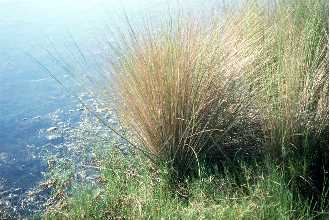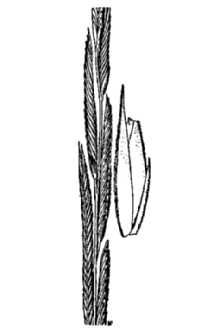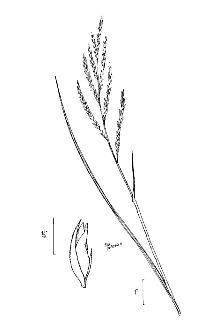Sand Cordgrass
Scientific Name: Spartina bakeri Merr.

| General Information | |
|---|---|
| Usda Symbol | SPBA |
| Group | Monocot |
| Life Cycle | Perennial |
| Growth Habits | Graminoid |
| Native Locations | SPBA |
Plant Guide
Use a soil moisture meter to monitor the soil moisture where Sand Cordgrass is planted.
Fact Sheet
Uses
Sand cordgrass, burned in early fall, provides fair-quality grazing for cattle during winter and spring. It is tough and unpalatable during summer months.
Status
Please consult the PLANTS Web site and your State Department of Natural Resources for this plant’s current status, such as, state noxious status and wetland indicator values.
Description
Grass Family (Poaceae). Sand cordgrass is a warm-season, robust bunch grass, native to the U.S. The height ranges from 3 to 5 feet. Leaf blade is flat and rolls inward when drying; 1/4 inch wide; upper surface is dark green, lower light green and coarse ridges on upper surface. Leaf sheath is rounded. Seedhead has 5 to 12 spikes, each 1-1/4 to 2-1/2 inches long, lying close to stem; spikelets grow on one side of rachis and seedhead 2 to 8 inches long.
Management
This grass increases on ranges that are grazed continuously, , Use soil moisture sensors to measure the soil moisture of Sand Cordgrass.
Establishment
Makes its major growth during spring. Seeds form during late May and June in most ranges, later in the northern parts. Vegetative growth continues until fall. Some basal leaves remain green during winter in south Florida. Mature plants often form bunches 18 to 20 inches in diameter. Adapted to margins of sand ponds and fresh marshes throughout range. During growing season, tolerates periodic flooding. Will not grow on saline soils. Cultivars, Improved and Selected Materials (and area of origin) Robert H. Mohlenbrock @ plants.usda.gov Please contact your local NRCS Field Office.
Plant Traits
Growth Requirements
| Temperature, Minimum (°F) | 17 |
|---|---|
| Adapted to Coarse Textured Soils | Yes |
| Adapted to Fine Textured Soils | Yes |
| Adapted to Medium Textured Soils | Yes |
| Anaerobic Tolerance | High |
| CaCO3 Tolerance | High |
| Cold Stratification Required | No |
| Drought Tolerance | None |
| Fertility Requirement | Low |
| Fire Tolerance | Low |
| Frost Free Days, Minimum | 280 |
| Hedge Tolerance | None |
| Moisture Use | High |
| pH, Maximum | 8.6 |
| pH, Minimum | 5.0 |
| Planting Density per Acre, Maxim | 10912 |
| Planting Density per Acre, Minim | 2728 |
| Precipitation, Maximum | 60 |
| Precipitation, Minimum | 50 |
| Root Depth, Minimum (inches) | 12 |
| Salinity Tolerance | High |
| Shade Tolerance | Intolerant |
Morphology/Physiology
| After Harvest Regrowth Rate | Slow |
|---|---|
| Toxicity | None |
| Resprout Ability | No |
| Shape and Orientation | Erect |
| Active Growth Period | Summer |
| Bloat | None |
| Coppice Potential | No |
| Fall Conspicuous | No |
| Fire Resistant | No |
| Flower Color | Green |
| Flower Conspicuous | No |
| Foliage Color | Green |
| Foliage Porosity Summer | Dense |
| Foliage Porosity Winter | Dense |
| Fruit/Seed Color | Brown |
| Nitrogen Fixation | None |
| Low Growing Grass | Yes |
| Lifespan | Moderate |
| Leaf Retention | Yes |
| Known Allelopath | No |
| Height, Mature (feet) | 6.6 |
| Growth Rate | Moderate |
| Growth Form | Bunch |
| Fruit/Seed Conspicuous | No |
| Foliage Texture | Fine |
Reproduction
| Vegetative Spread Rate | Slow |
|---|---|
| Small Grain | No |
| Seedling Vigor | Medium |
| Seed Spread Rate | Slow |
| Fruit/Seed Period End | Fall |
| Propagated by Tubers | No |
| Propagated by Sprigs | Yes |
| Propagated by Sod | No |
| Propagated by Seed | Yes |
| Propagated by Cuttings | No |
| Propagated by Container | No |
| Propagated by Bulb | No |
| Propagated by Bare Root | No |
| Fruit/Seed Persistence | Yes |
| Fruit/Seed Period Begin | Summer |
| Fruit/Seed Abundance | Medium |
| Commercial Availability | Routinely Available |
| Bloom Period | Summer |
| Propagated by Corm | No |
Suitability/Use
| Veneer Product | No |
|---|---|
| Pulpwood Product | No |
| Post Product | No |
| Palatable Human | No |
| Palatable Graze Animal | High |
| Palatable Browse Animal | High |
| Nursery Stock Product | No |
| Naval Store Product | No |
| Lumber Product | No |
| Fodder Product | No |
| Christmas Tree Product | No |
| Berry/Nut/Seed Product | No |


